coolant level CHEVROLET S10 1996 2.G Owners Manual
[x] Cancel search | Manufacturer: CHEVROLET, Model Year: 1996, Model line: S10, Model: CHEVROLET S10 1996 2.GPages: 375, PDF Size: 20.73 MB
Page 108 of 375
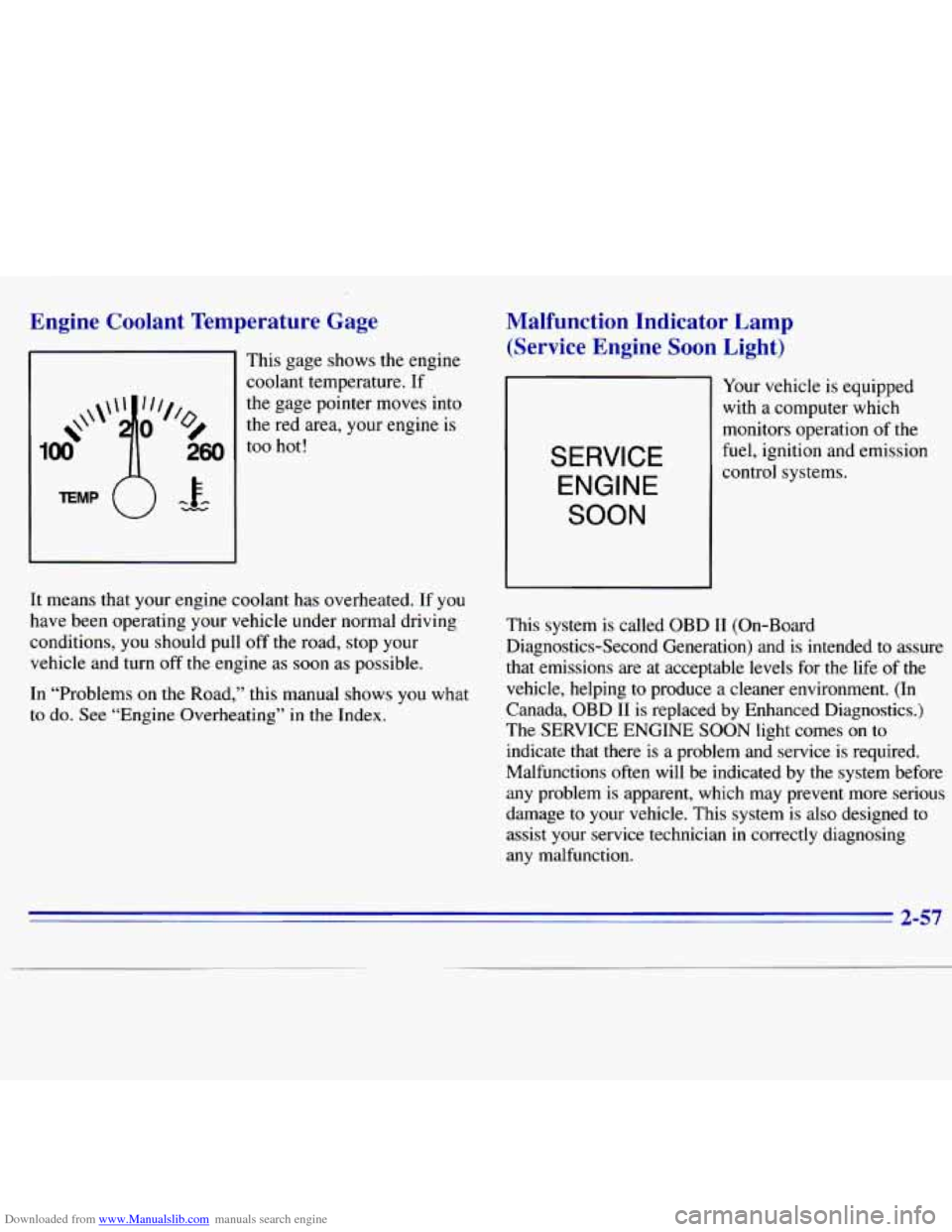
Downloaded from www.Manualslib.com manuals search engine Engine Coolant Temperature Gage
This gage shows the engine
coolant temperature.
If
the gage pointer moves into
the red area, your engine is
260 too hot!
TEMP
Malfunction Indicator Lamp
(Service Engine Soon Light)
Your vehicle is equipped
with a computer which
monitors operation of the
fuel, ignition and emission
SERVICE
ENGINE
SOON
control systems.
It means that your engine coolant has overheated. If you
have been operating your vehicle under normal driving
conditions, you should pull off the road, stop your
vehicle and turn off
the engine as soon as possible.
In “Problems on the Road,” this manual shows you
what
to do. See “Engine Overheating” in the Index. This
system is called
OBD I1 (On-Board
Diagnostics-Second Generation) and is intended
to assure
that emissions are at acceptable levels for the life of the
vehicle, helping to produce a cleaner environment.
(In
Canada, OBD I1 is replaced by Enhanced Diagnostics.)
The SERVICE ENGINE SOON light comes on to
indicate that there is a problem and service
is required.
Malfunctions often will be indicated by the system before
any problem is apparent, which may prevent more serious
damage to your vehicle. This system
is also designed to
assist your service technician
in correctly diagnosing
any malfunction.
2-57
Page 185 of 375
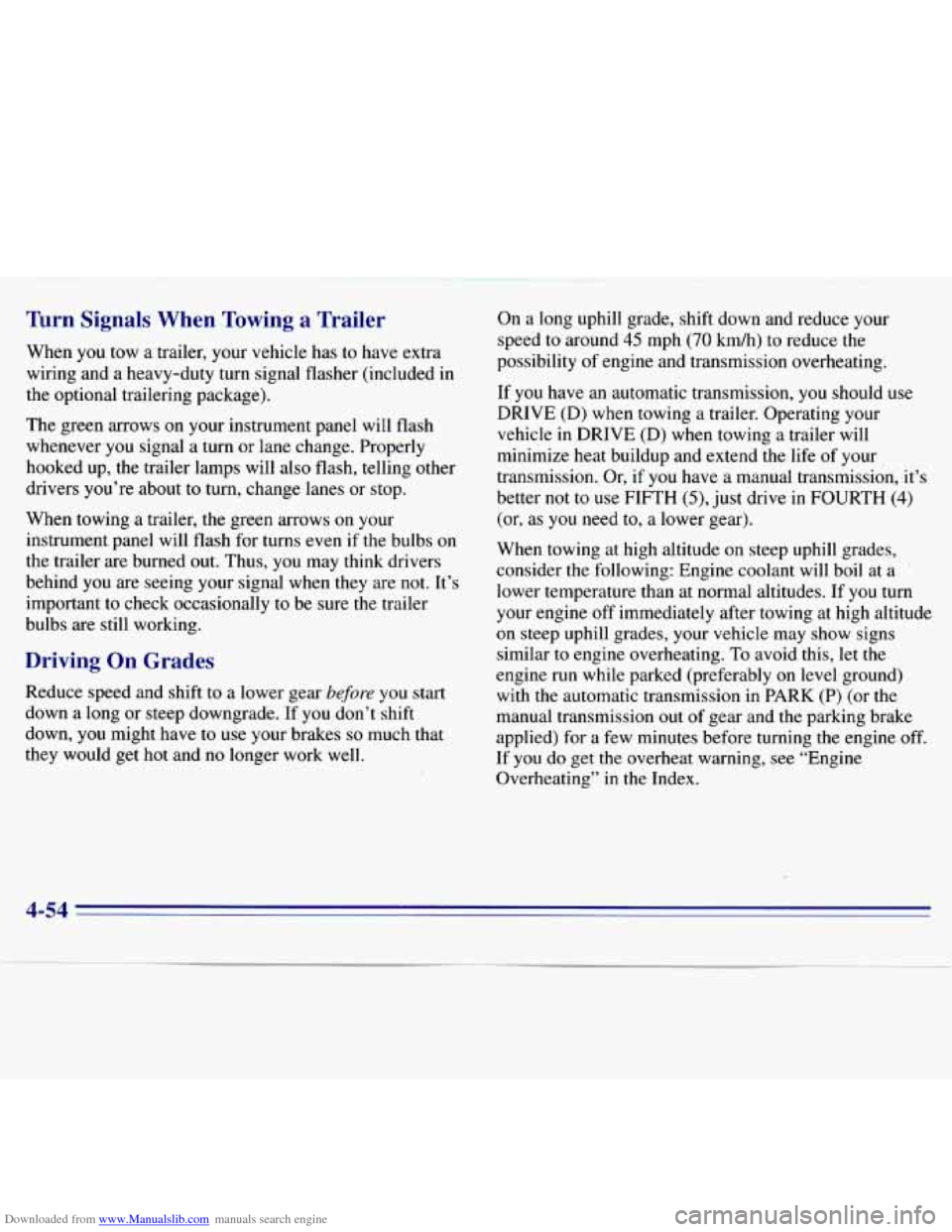
Downloaded from www.Manualslib.com manuals search engine Turn Signals When Towing a Trailer
When you tow a trailer, your vehicle has to have extra
wiring and a heavy-duty turn signal flasher (included
in
the optional trailering package).
The green arrows on your instrument panel will flash
whenever you signal a turn or lane change. Properly
hooked up, the trailer lamps will also flash, telling other
drivers you’re about to turn, change lanes or stop.
When towing a trailer, the green arrows on your
instrument panel will flash for turns even if the bulbs on
the trailer are burned out. Thus, you may think drivers
behind
you are seeing your signal when they are not. It’s
important
to check occasionally to be sure the trailer
bulbs are still working.
Driving On Grades
Reduce speed and shift to a lower gear before you start
down a long or steep downgrade. If you don’t shift
down,
you might have to use your brakes so much that
they would get hot and no longer work well, On
a long uphill grade, shift down and reduce your
speed to around
45 mph (70 kdh) to reduce the
possibility of engine
and transmission overheating.
If you have an automatic transmission, you should use
DRIVE (D) when towing a trailer. Operating your
vehicle in DRIVE (D) when towing a trailer will
minimize heat buildup and extend the life of your
transmission. Or, if you have a manual transmission, it’s
better not to use FIFTH
(5), just drive in FOURTH (4)
(or, as you need to, a lower gear).
When towing at high altitude on steep uphill grades,
consider the following: Engine coolant will boil
at a
lower temperature than at normal altitudes. If you turn
your engine off immediately after towing at high altitude
on steep
uphill grades, your vehicle may show signs
similar to engine overheating. To avoid this, let the
engine run while parked (preferably on level ground)
with the automatic transmission in PARK
(P) (or the
manual transmission out of gear and the parking brake
applied) for
a few minutes before turning the engine off.
If you do get the overheat warning, see “Engine
Overheating’’
in the Index.
4-54
Page 204 of 375
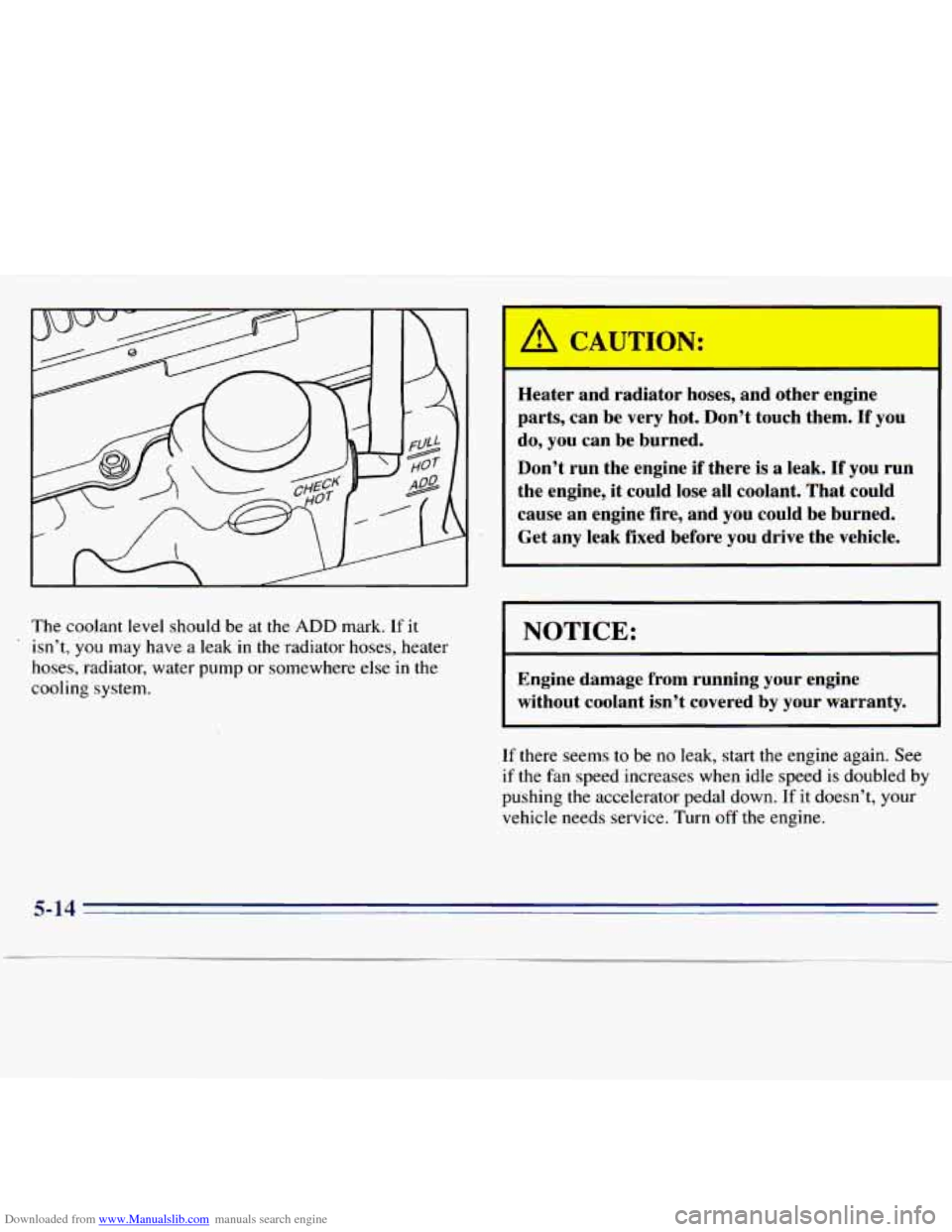
Downloaded from www.Manualslib.com manuals search engine The coolant level should be at the ADD mark. If it
‘ isn’t, you may have a leak in the radiator hoses, heater
hoses, radiator, water pump
or somewhere else in the
cooling system.
A CAUTION:
Heater and radiator hoses, and other e Jne
parts, can be very hot. Don’t touch them.
If you
do, you can be burned.
Don’t run the engine if there is a leak.
If you run
the engine, it could lose all coolant. That could
cause an engine fire, and you could be burned.
Get any leak fixed before you drive the vehicle.
I NOTICE:
I
Engine damage from running your engine
without coolant isn’t covered by your warranty.
If there seems to be no leak, start the engine again. See
if the fan speed increases when idle speed is doubled by
pushing the accelerator pedal down.
If it doesn’t, your
vehicle needs service. Turn off the engine.
5-14
Page 205 of 375

Downloaded from www.Manualslib.com manuals search engine How to Add Coolant to the
Coolant Recovery Tank
If you haven’t found a problem yet, but the coolant level
isn’t at
ADD, add a 50/50 mixture of clean water
(preferably distilled) and DEX-COOL TM (orange-colored,
silicate-free) antifreeze at the coolant recovery tank. (See
“Engine Coolant” in the Index for more information.)
k!, CAUTICJ:
Adding only plain. water to your cooling system
can be dangerous. Plain water, or some other
liquid like alcohol, can boil before the proper
coolant mix will. Your vehicle’s coolant warning
system
is set for the proper coolant mix. With
plain water or the wrong mix, your engine could
get too hot but you wouldn’t get the overheat
warning. Your engine could catch fire and you
or
others could be burned. Use a 5W50 mix of clean
water and
DEX-COOL TM antifreeze.
I NOTICE:
In cold weather, water can freeze and crack the
engine, radiator, heater core and other parts.
Use the recommended coolant and the proper
coolant mix.
Page 210 of 375
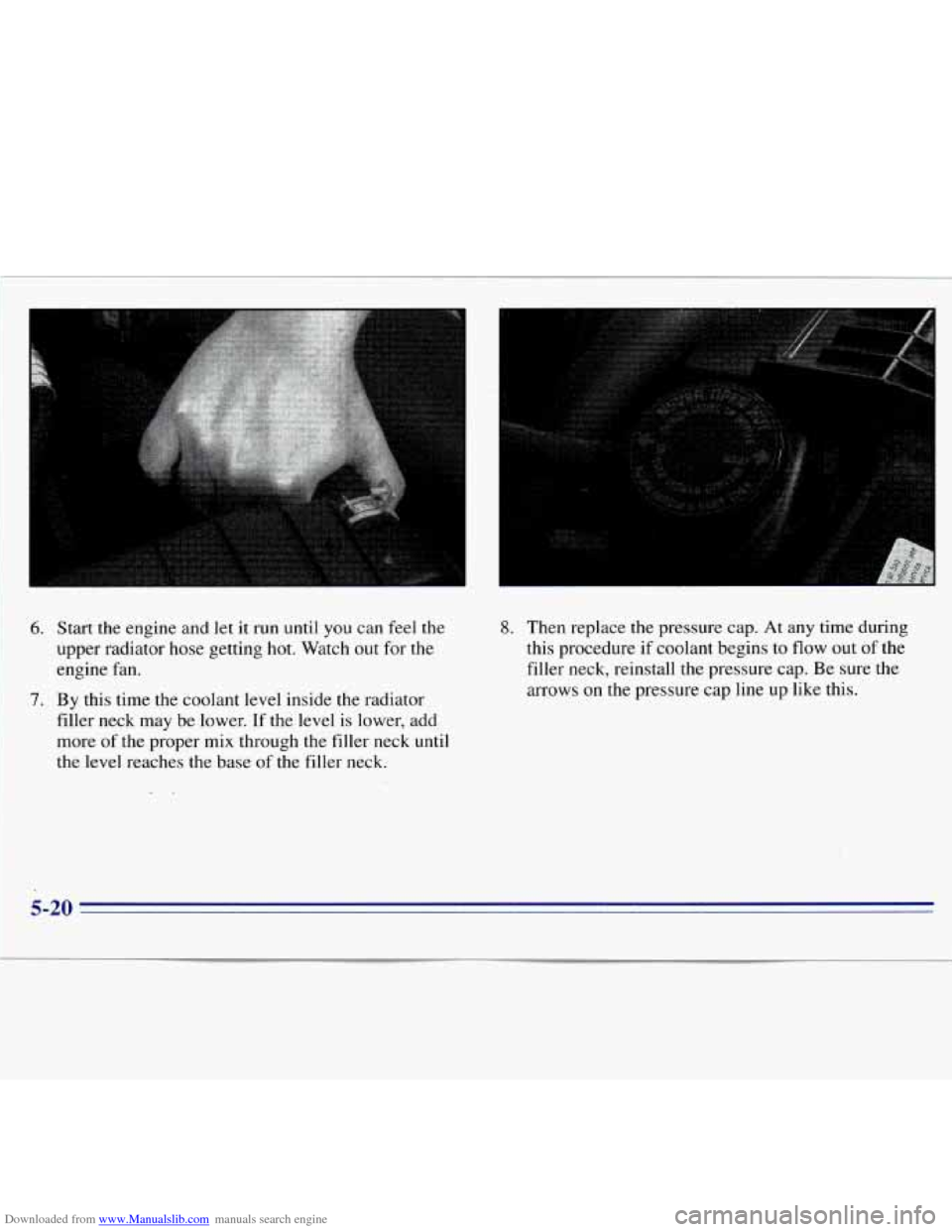
Downloaded from www.Manualslib.com manuals search engine 6. Start the engine and let it run until you can feel the
upper radiator hose getting hot. Watch out for the
engine fan.
7. By this time the coolant level inside the radiator
filler neck may be lower. If the level is lower, add
more of the proper mix through the filler neck
until
the level reaches the base of the filler neck.
8. Then replace the pressure cap. At any time during
this procedure if coolant begins to flow out of the
filler neck, reinstall
the pressure cap. Be sure the
arrows on the pressure cap line up like this.
5-20 .
Page 250 of 375
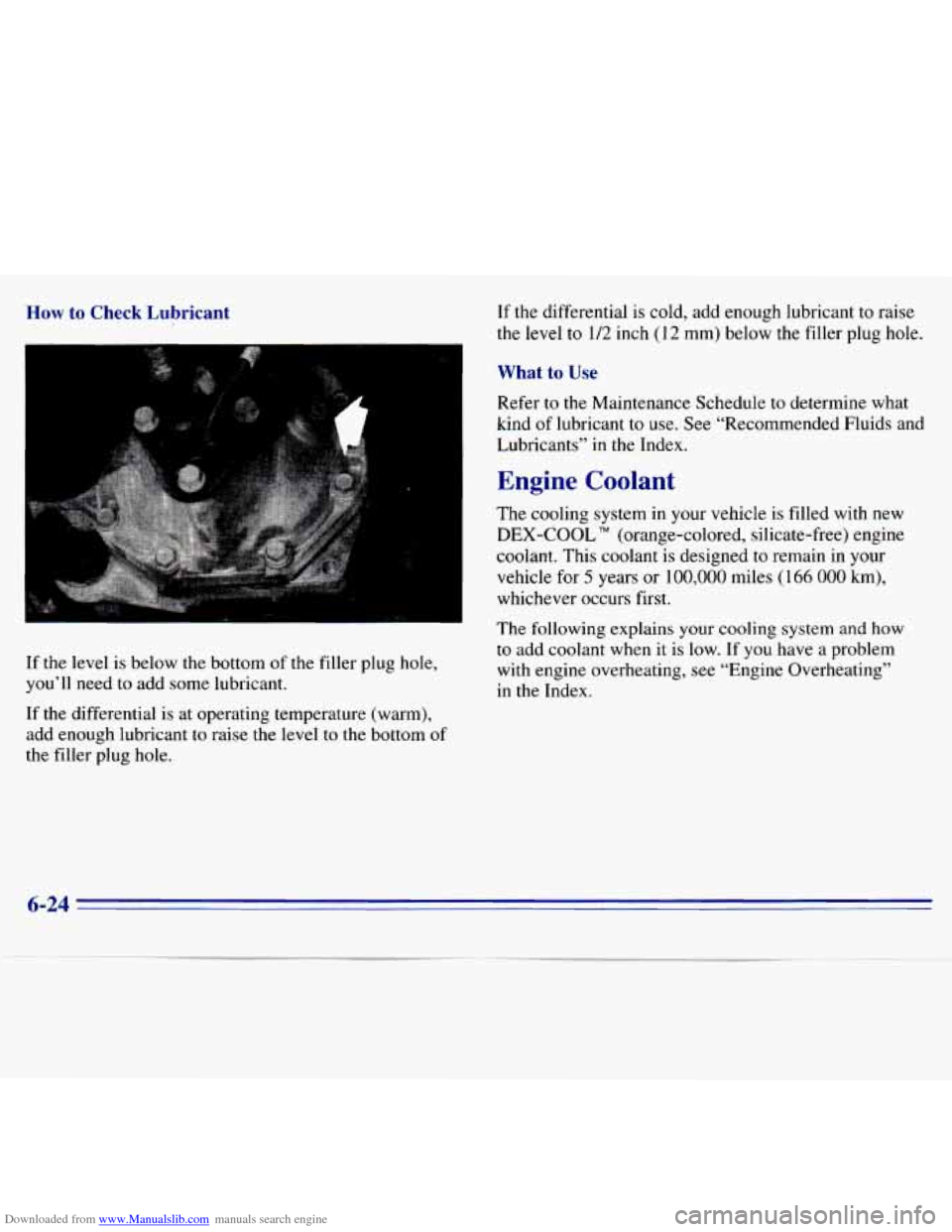
Downloaded from www.Manualslib.com manuals search engine How to Check Lubricant
If the level is below the bottom of the filler plug hole,
you’ll need to add some lubricant.
If the differential is at operating temperature (warm),
add enough lubricant
to raise the level to the bottom of
the filler plug hole. If
the differential is cold, add enough lubricant to raise
the level
to 1/2 inch (12 mm) below the filler plug hole.
What to Use
Refer to the Maintenance Schedule to determine what
kind of lubricant to use. See “Recommended Fluids
and
Lubricants’’ in the Index.
Engine Coolant
The cooling system in your vehicle is filled with new
DEX-COOL R’l (orange-colored, silicate-free) engine
coolant. This coolant is designed to remain in your
vehicle for
5 years or 100,000 miles ( 166 000 km),
whichever occurs first.
The following explains your cooling system and
how
to add coolant when it is low. If you have a problem
with engine overheating, see “Engine Overheating”
in the Index.
6-24
Page 252 of 375
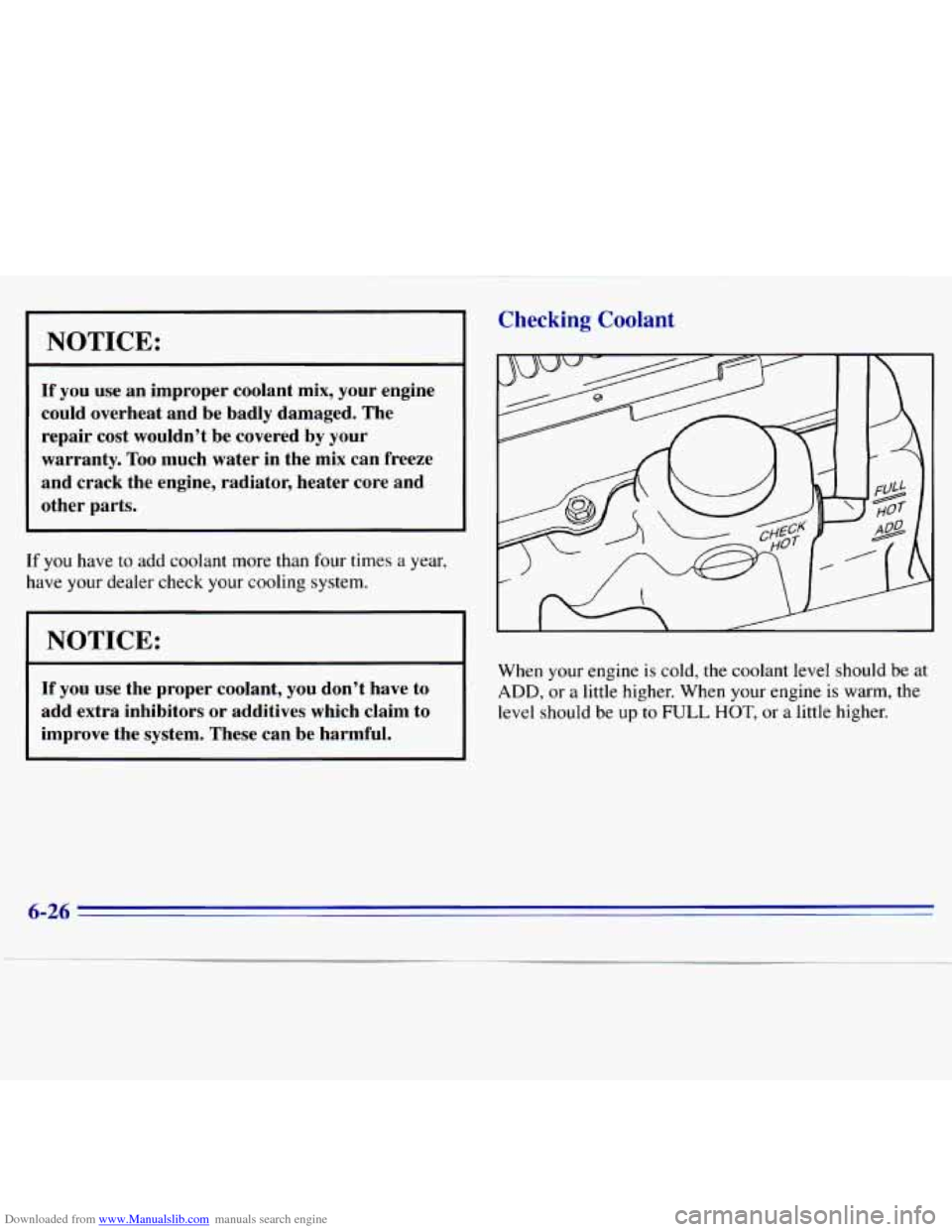
Downloaded from www.Manualslib.com manuals search engine NOTICE:
r
If you use an improper coolant mix, your engine
could overheat and be badly damaged. The
repair
cost wouldn’t be covered by your
warranty.
Too much water in the mix can freeze
and crack the engine, radiator, heater core and
other parts.
If you have to add coolant more than four times a year,
have your dealer check your cooling system.
I NOTICE: I
If you use the proper coolant, you don’t have to
add extra inhibitors or additives which claim to
improve the system. These can be harmful.
Checking Coolant
When your engine is cold, the coolant level should be at
ADD, or a little higher. When your engine is warm, the
level should be
LID to FULL HOT, or a little higher.
6-26
Page 326 of 375
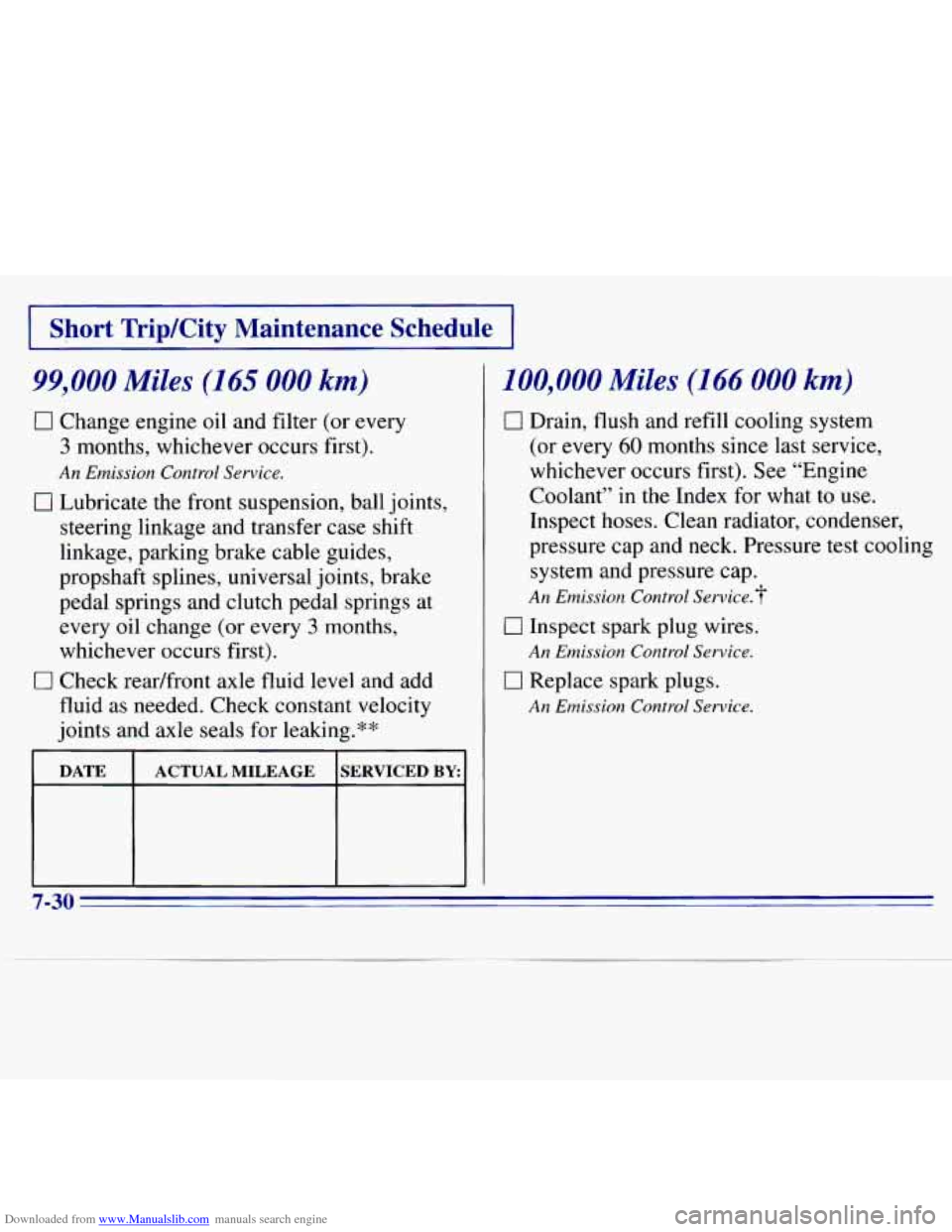
Downloaded from www.Manualslib.com manuals search engine I Short Trip/City Maintenance Schedule I
99,000 Miles (165 000 km)
0 Change engine oil and filter (or every
3 months, whichever occurs first).
An Emission Control Service.
100,000 Miles (166 000 km)
0 Drain, flush and refill cooling system
(or every
60 months since last service,
whichever occurs first). See “Engine
U
[7 Lubricate the front suspension, ball joints, Coolant’’ in
the Index for what to use.
steering linkage and transfer case shift
propshaft splines, universal joints, brake pressure
cap and neck. Pressure test cooling
linkage, parking brake cable guides, Inspect hoses. Clean radiator, condenser,
system and pressure cap.
pedal springs and clutch pedal springs at
An Emission Control Service.?
every oil change (or every 3 months, 0 Inspect spark plug wires.
whichever occurs first).
An Emission Control Service.
fluid as needed. Check constant velocity An Emission Control Service.
joints and axle seals for leaking.**
0 Check readfront axle fluid level and add 0 Replace spark plugs.
DATE SERVICED BY ACTUAL MILEAGE
>-, - - -- -- - ~-
7-30
Page 343 of 375
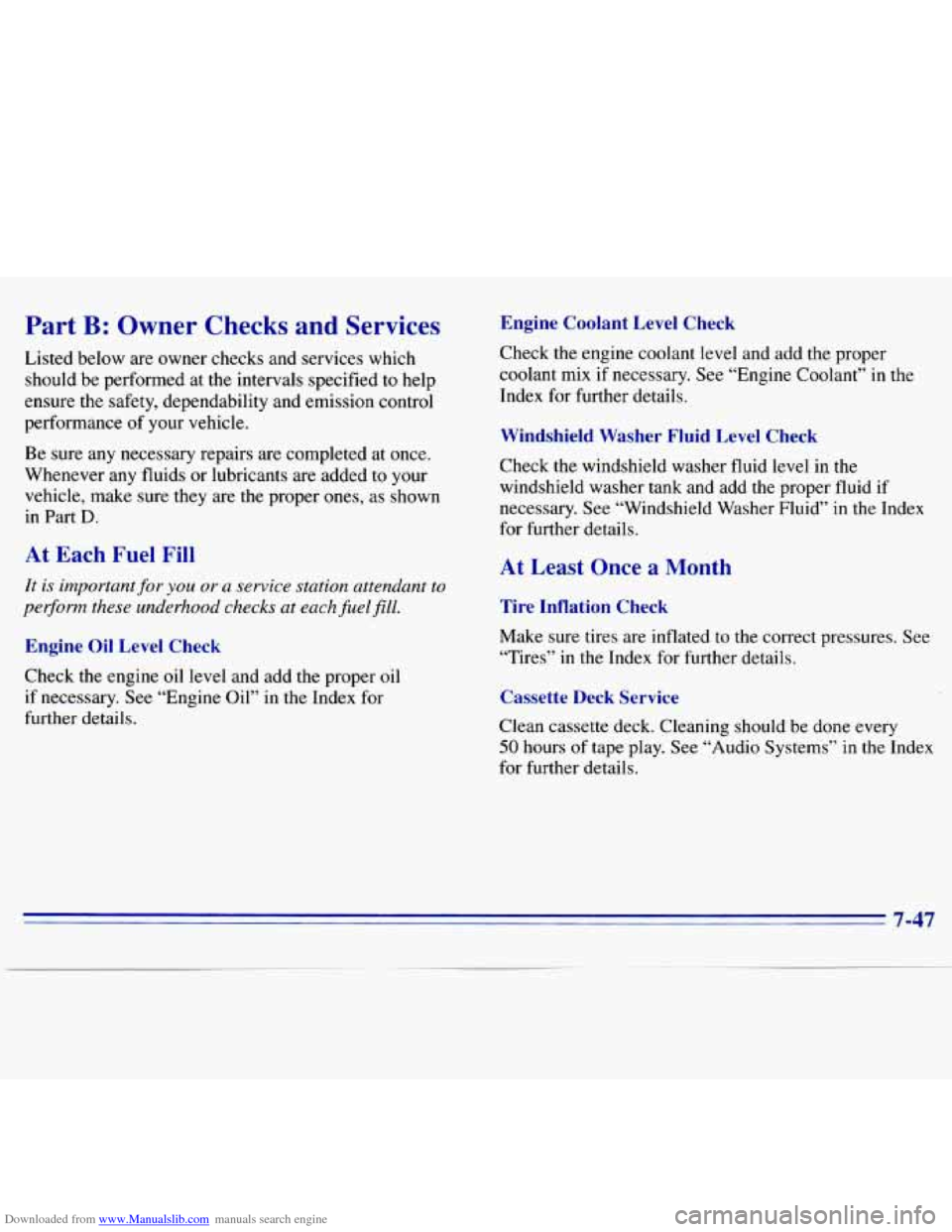
Downloaded from www.Manualslib.com manuals search engine Part B: Owner Checks and Services
Listed below are owner checks and services which
should be performed
at the intervals specified to help
ensure the safety, dependability and emission control
performance
of your vehicle.
Be sure
any necessary repairs are completed at once.
Whenever any fluids or lubricants are added
to your
vehicle, make sure they are the proper ones, as shown
in Part
D.
At Each Fuel Fill
It is important for you or a service station attendant to
pegorm these underhood checks at each fuel
fill.
Engine Oil Level Check
Check the engine oil level and add the proper oil
if necessary. See “Engine Oil” in the Index for
further details.
Engine Coolant Level Check
Check the engine coolant level and add the proper
coolant mix if necessary. See “Engine Coolant” in
the
Index for further details.
Windshield Washer Fluid Level Check
Check the windshield washer fluid level in the
windshield washer tank and add the proper fluid if
necessary. See “Windshield Washer Fluid” in the Index
for further details.
At Least -Once a Month
Tire Inflation Check
Make sure tires are inflated to the correct pressures. See
“Tires”
in the Index for further details.
Cassette Deck Service
Clean cassette deck. Cleaning should be done every
50 hours of tape play. See “Audio Systems” in the Index
for further details.
7-47
Page 367 of 375
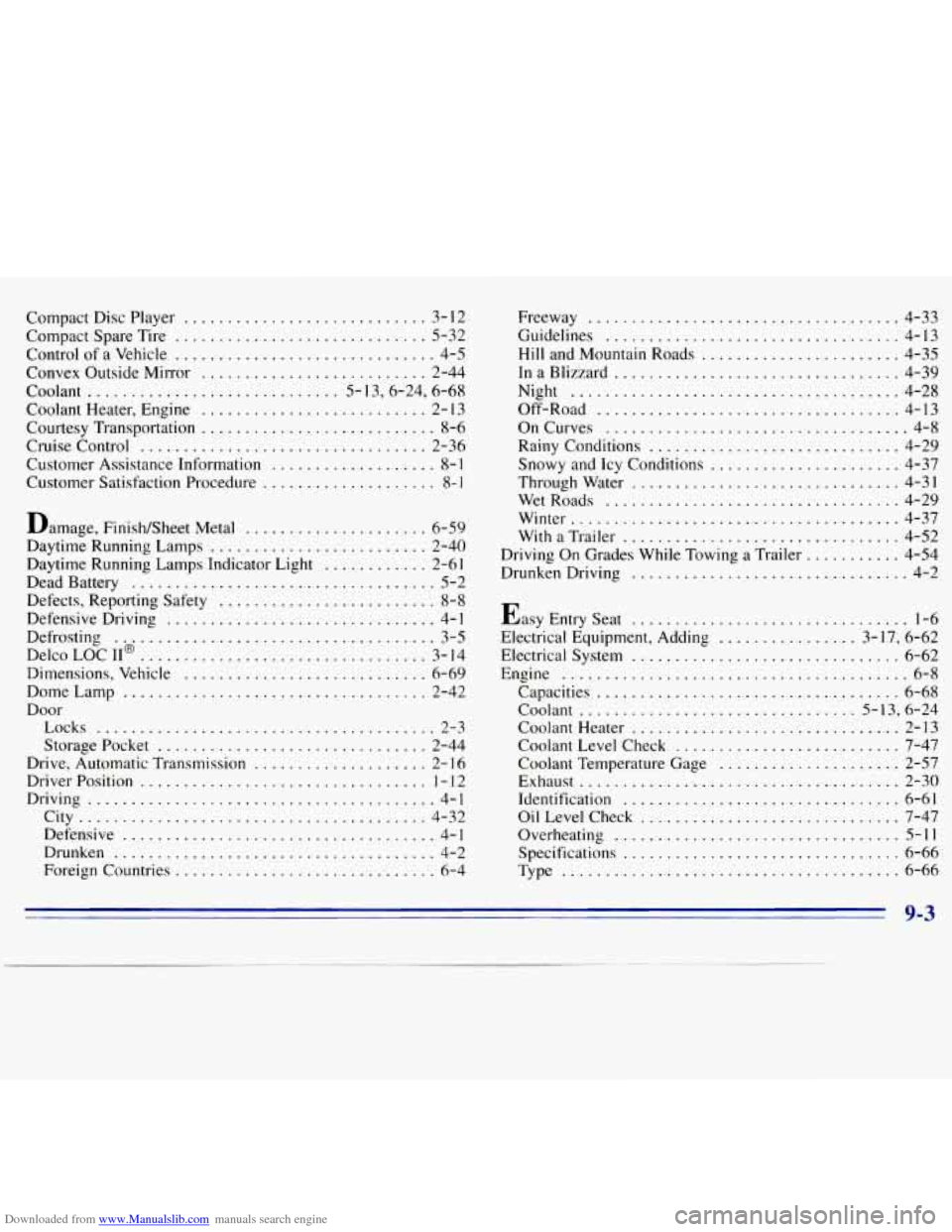
Downloaded from www.Manualslib.com manuals search engine Compact Disc Player ............................ 3- I2
Compact Spare Tire ............................. 5-32
Control of
a Vehicle .............................. 4-5
Convex Outside Mirror
.......................... 2-44
Coolant
............................. 5- 13.6.24. 6.68
Coolant Heater. Engine .......................... 2- I3
Courtesy Transportation ........................... 8-6
Cruise Control ................................. 2-36
Customer Assistance Information
................... 8-1
Customer Satisfaction Procedure .................... 8- 1
Damage. Finish/Sheet Metal ..................... 6-59
Daytime Running Lamps ......................... 2-40
Daytime Running Lamps Indicator Light
............ 2-61
Dead Battery
................................... 5-2
Defects. Reporting Safety ......................... 8-8
Defensive Driving ............................... 4- I
Defrosting .................................... 3-5
Delco LOC 11' ................................. 3- 14
Dimensions. Vehicle
............................ 6-69
DomeLamp ................................... 2-42
Door Locks
....................................... 2-3
StoragePocket
............................... 2-44
Drive. Automatic Transmission
.................... 2- 16
DriverPosition ................................. 1-12
Driving
........................................ 4-1
City ........................................ 4-32
Defensive
.................................... 4-1
Drunken ..................................... 4-2
Foreign Countries
.............................. 6-4 Freeway
.................................... 4-33
Guidelines
.................................. 4-13
Hill and Mountain Roads
....................... 4-35
InaBlizzard
................................. 4-39
Night
...................................... 4-28
Off-Road
................................... 4-13
OnCurves
................................... 4-8
Rainy Conditions
............................. 4-29
Snowy and Icy Conditions
...................... 4-37
Throughwater
............................... 4-31
WetRoads
.................................. 4-29
Winter
...................................... 4-37
With
a Trailer ................................ 4-52
DrunkenDriving
................................ 4-2
Driving
On Grades While Towing
a Trailer ........... 4-54
Easy Entry Seat
................................ 1-6
Electrical Equipment. Adding ................ 3-1.7, 6-62
Electrical System
............................... 6-62
Capacities
................................... 6-68
Coolant ................................ 5- 13. 6-24
Coolant Heater ............................... 2-13
Coolant Level Check
.......................... 7-47
Coolant Temperature Gage
..................... 2-57
Exhaust
..................................... 2-30
Identification ................................ 6-61
OilLevelCheck
.............................. 7-47
Overheating
................................. 5-11
Specifications ................................ 6-66
Type ........................................ 6-66
Engine
........................................ 6-8
9-3